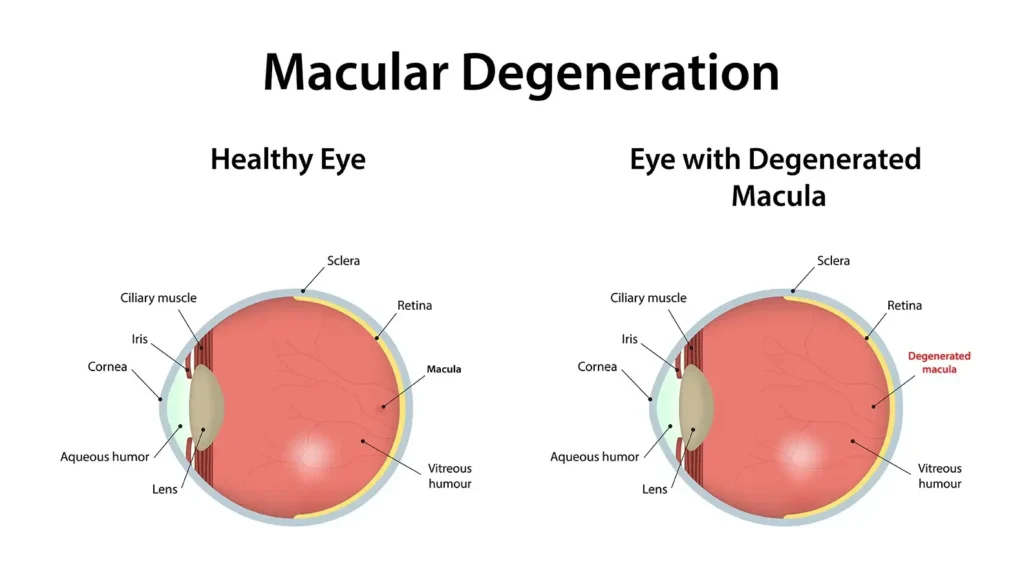MACULAR DEGENERATION

TWO TYPES OF AMD
DRY AMD
This form is quite common. About 80% (8 out of 10) people who have AMD have the dry form. Dry AMD is when parts of the macula get thinner with age and tiny clumps of protein called drusen grow. You slowly lose central vision. There is no way to treat dry AMD yet.
WET AMD
This form is less common but much more serious. Wet AMD is when new, abnormal blood vessels grow under the retina. These vessels may leak blood or other fluids, causing scarring of the macula. You lose vision faster with wet AMD than with dry AMD. Many people don’t realize they have AMD until their vision is very blurry. This is why it is important to have regular visits to an ophthalmologist. He or she can look for early signs of AMD before you have any vision problems.
WHO IS AT RISK FOR MACULAR DEGENERATION?
You are more likely to develop AMD if you:
- eat a diet high in saturated fat (found in foods like meat, butter, and cheese)
- are overweight
- smoke cigarettes
- are over 50 years old
- have a family history of AMD
- are Caucasian (white)
Having heart disease is another risk factor for AMD, as is having high cholesterol levels.
MACULAR DEGENERATION DIAGNOSIS: HOW IS AMD DIAGNOSED?
DRY AMD
Right now, there is no way to treat the dry form of AMD. However people with lots of drusen or serious vision loss might benefit from taking a certain combination of nutritional supplements. A large study found those people may slow their dry AMD by taking these vitamins and minerals daily:
- Vitamin C (500 mg)
- Vitamin E (400 IU)
- Lutein (10 mg)
- Zeaxanthin (2 mg)
- Zinc (80 mg)
- Copper (2 mg)
Your ophthalmologist can tell you if vitamins and minerals are recommended for your dry AMD.
WET AMD
To help treat wet AMD, there are medications called anti-VEGF drugs. Anti-VEGF treatment helps reduce the number of abnormal blood vessels in your retina. It also slows any leaking from blood vessels. This medicine is delivered to your eye through a very slender needle.
Laser surgery may also be used to treat some types of wet AMD. Your eye surgeon shines a laser light beam on the abnormal blood vessels. This reduces the number of vessels and slows their leaking.
Talk with your ophthalmologist about ways to treat your AMD.
TEST YOUR VISION WITH THE AMSLER GRID

Here is how to use the Amsler grid:
- Keep the Amsler grid in a place where you see it every day. Many people keep an Amsler grid on their refrigerator door or on their bathroom mirror.
- In good light, look at the grid from about 12–15 inches away. Be sure to wear your reading glasses if you normally use them.
- Cover one eye. Look directly at the dot in the center of the grid with your uncovered eye. Notice if any of the lines look bent or wavy. See if any part of the grid looks blurry, dim, or out of shape.
- Now cover your other eye and test your vision this same way again.
- Call your ophthalmologist right away if you notice that any lines or parts of the grid look wavy, blurry, or dim.
